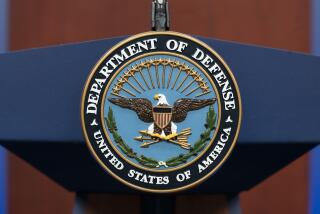Editorial: At last, an end to the U.S. deployment in Afghanistan

- Share via
President Biden’s expected announcement Wednesday that he will begin removing all U.S. troops from Afghanistan by the end of the month and complete the withdrawal by Sept. 11, the 20th anniversary of the terror attacks that provoked the war, will finally bring to a close direct American military involvement there.
But as the administration has said, it will not end the government’s role in trying to broker a lasting peace and regional stability. “What we won’t do is use our troops as a bargaining chip in that process,” a government official told the Washington Post, which first reported the development.
The situation remains dicey. The Trump administration signed an agreement last year to remove the last of U.S. troops by May 1 (which also would precipitate withdrawals by NATO allies), but that date was thrown into doubt after security officials warned that a precipitous departure could add to the instability and increase the chances of the country descending back into civil war.
It’s unclear whether that risk diminishes if the U.S. waits until the end of summer to be gone, or what the Taliban might do in the interim (it has resisted attacking U.S. troops since the agreement). But the timing of our departure has been problematic ever since President George W. Bush launched the U.S. invasion of Afghanistan in the aftermath of the 9/11 terror attacks two decades ago. His and successive administrations have long struggled to craft an exit plan from a deployment that once peaked at about 100,000 troops.
What is clear is that it is in the best interests of Afghan President Ashraf Ghani, the Taliban and the U.S. to reach a lasting peace accord before the withdrawal of U.S. and allied troops. And at this point in that seemingly endless engagement, the departure of U.S. troops might compel the compromises necessary to achieve peace.
The original allied goal was to destroy the Al Qaeda training bases and oust from power the Taliban regime of Islamist hard-liners who sheltered the terrorist network. Those goals were met, but we’ve had far less success standing up a sustainable, self-sufficient Afghan government. And we’ve been unable to broker a successful conclusion to the molasses-like negotiations between the Afghan government and a resurgent Taliban.
Continuing to risk American lives in Afghanistan has limited appeal to the American public, which is more focused on jobs, the economy and the COVID-19 pandemic than the situation in Afghanistan. That doesn’t mean the Biden administration should slip the estimated 3,500 remaining U.S. troops out while Americans are distracted, but that the lack of clear options suggests the president would encounter little significant political opposition from a nation tired of war.
So the president is right to make this move, but he also must make certain that the U.S. and its allies continue to exert whatever diplomatic influence they can to keep the sporadic attacks by each side from escalating into open civil war, and to ensure the region doesn’t become a fresh nest for terrorists. The best path to a sustainable peace, and political and social stability, is that the Afghans themselves negotiate the path to their own future.
More to Read
A cure for the common opinion
Get thought-provoking perspectives with our weekly newsletter.
You may occasionally receive promotional content from the Los Angeles Times.










